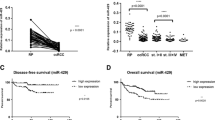Abstract
Renal cell carcinoma (RCC) is the most common malignant renal tumor and is prone to metastasis. However, the molecular variation and mechanism underlying renal cell carcinoma metastasis remains largely unknown. In our previous study, it was found that MYSM-1 was significantly downregulated in renal cell carcinoma tissues as compared with normal renal tissues without metastasis, using proteomics approach. Therefore, we hypothesized that MYSM-1 may suppress the metastasis of renal cell carcinoma in light of paucity of data regarding MYSM-1 in the cancers. In the present study, to confirm the expression status of MYSM-1 in renal cell carcinoma, immunohistochemistry with renal carcinoma tissue microarray was performed. It was shown that MYSM-1 was remarkably decreased in renal carcinoma tissues compared with paired normal control tissues; and that low expression of MYSM-1 was significantly associated with poor overall prognosis and metastasis. To investigate the biological roles of MYSM-1 in vitro in renal carcinoma cell lines, both knockdown using siRNA and over-expression were carried out. It was found that MYSM-1 could suppress the proliferation, migration, and invasion of renal carcinoma cells. In addition, we found that MYSM-1 could inhibit the epithelial-mesenchymal transition. Together, our results demonstrate that MYSM-1 could suppress the metastasis of renal carcinoma cells may be through inhibiting the epithelial-mesenchymal transition (EMT) process.






Similar content being viewed by others
References
G. Courthod, M. Tucci, M. Di Maio, G.V. Scagliotti, Papillary renal cell carcinoma: a review of the current therapeutic landscape, Crit Rev Oncol Hematol (2015).
Hutchinson L. Imaging: improving detection of bone metastases in renal cell carcinoma. Nat Rev Clin Oncol. 2015;12:503.
Yoneyama M, Tochio N, Umehara T, Koshiba S, Inoue M, Yabuki T, et al. Structural and functional differences of SWIRM domain subtypes. J Mol Biol. 2007;369:222–38.
Le G, Touzot F, Andre-Schmutz I, Lagresle-Peyrou C, France B, Kermasson L, et al. An in vivo genetic reversion highlights the crucial role of Myb-Like, SWIRM, and MPN domains 1 (MYSM1) in human hematopoiesis and lymphocyte differentiation. J Allergy Clin Immunol. 2015;6749(15):00800–3.
Gatzka M, Tasdogan A, Hainzl A, Allies G, Maity P, Wilms C, et al. Interplay of H2A deubiquitinase 2A-DUB/Mysm1 and the p19(ARF)/p53 axis in hematopoiesis, early T-cell development and tissue differentiation. Cell Death Differ. 2015;22:1451–62.
DiTommaso T, Jones LK, Cottle DL, Program WMG, Gerdin AK, Vancollie VE, et al. Identification of genes important for cutaneous function revealed by a large scale reverse genetic screen in the mouse. PLoS Genet. 2014;10:e1004705.
Liakath-Ali K, Vancollie VE, Heath E, Smedley DP, Estabel J, Sunter D, et al. Novel skin phenotypes revealed by a genome-wide mouse reverse genetic screen. Nat Commun. 2014;5:3540.
Holmseth S, Zhou Y, Follin-Arbelet VV, Lehre KP, Bergles DE, Danbolt NC. Specificity controls for immunocytochemistry: the antigen preadsorption test can lead to inaccurate assessment of antibody specificity. J Histochem Cytochem. 2012;60:174–87.
Hewitt SM, Baskin DG, Frevert CW, Stahl WL, Rosa-Molinar E. Controls for immunohistochemistry: The Histochemical Society’s standards of practice for validation of immunohistochemical assays. J Histochem Cytochem. 2014;62:693–7.
Jiang XX, Nguyen Q, Chou Y, Wang T, Nandakumar V, Yates P, et al. Control of B cell development by the histone H2A deubiquitinase MYSM1. Immunity. 2011;35:883–96.
Nijnik A, Clare S, Hale C, Raisen C, McIntyre RE, Yusa K, et al. The critical role of histone H2A-deubiquitinase Mysm1 in hematopoiesis and lymphocyte differentiation. Blood. 2012;119:1370–9.
Nandakumar V, Chou Y, Zang L, Huang XF, Chen SY. Epigenetic control of natural killer cell maturation by histone H2A deubiquitinase, MYSM1. Proc Natl Acad Sci U S A. 2013;110:E3927–36.
Won H, Nandakumar V, Yates P, Sanchez S, Jones L, Huang XF, et al. Epigenetic control of dendritic cell development and fate determination of common myeloid progenitor by Mysm1. Blood. 2014;124:2647–56.
Wang T, Nandakumar V, Jiang XX, Jones L, Yang AG, Huang XF, et al. The control of hematopoietic stem cell maintenance, self-renewal, and differentiation by Mysm1-mediated epigenetic regulation. Blood. 2013;122:2812–22.
Belle JI, Langlais D, Petrov JC, Pardo M, Jones RG, Gros P, et al. p53 mediates loss of hematopoietic stem cell function and lymphopenia in Mysm1 deficiency. Blood. 2015;125:2344–8.
Baker M. Reproducibility crisis: blame it on the antibodies. Nature. 2015;521:274–6.
M.A. Helsby, J.R. Fenn, A.D. Chalmers, Reporting research antibody use: how to increase experimental reproducibility, F1000Res 2 (2013) 153.
Acknowledgments
The work was supported by National Clinical Research Center of Cancer, Key Laboratory of Cancer Prevention and Therapy project.
Author information
Authors and Affiliations
Corresponding author
Ethics declarations
Conflict of interest
The authors declare that they have no competing interests.
Electronic supplementary material
Below is the link to the electronic supplementary material.
Supplementary Table 1
(DOCX 13kb)
Supplementary Table 2
(DOCX 13kb)
Supplementary Table 3
(DOCX 14kb)
Supplementary Fig. 4
Evaluation of the specificity of primary antibody againt MYSM-1 that was used in the present study before immunohistochemistry. (DOCX 704kb)
Rights and permissions
About this article
Cite this article
Zhou, L., Shi, L., Guo, H. et al. MYSM-1 suppresses migration and invasion in renal carcinoma through inhibiting epithelial-mesenchymal transition. Tumor Biol. 37, 15583–15591 (2016). https://doi.org/10.1007/s13277-015-4138-z
Received:
Accepted:
Published:
Issue Date:
DOI: https://doi.org/10.1007/s13277-015-4138-z




